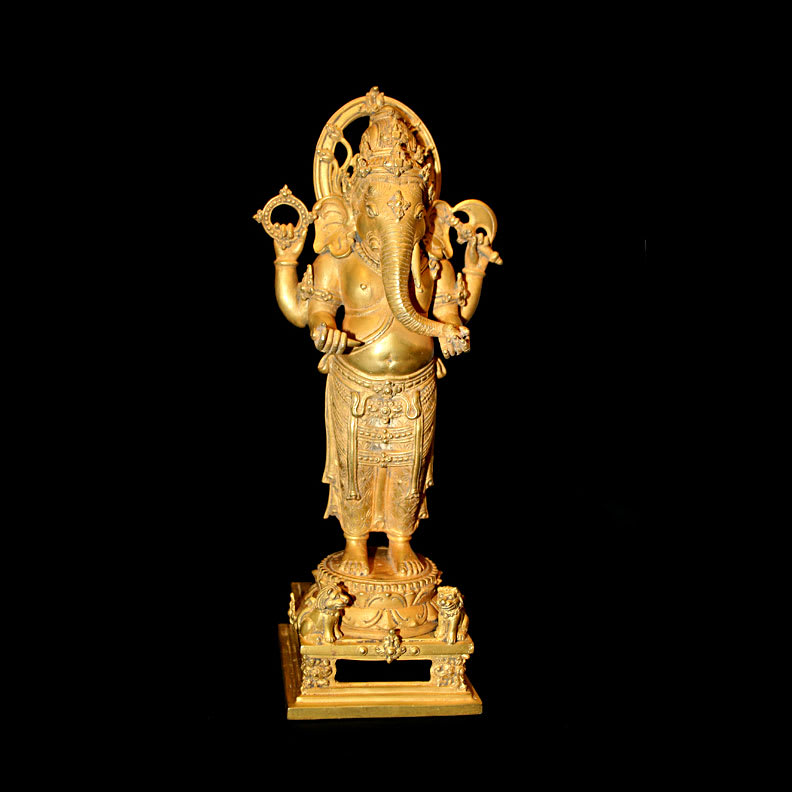Balinese Gold Figure of Ganesha, 900 CE - 1300 CE
Gold
height 24.8 cm
height 9 3/4 in
height 9 3/4 in
DG.057
Further images
This outstanding gold Ganesha was made in Bali. Buddhism does have a long history in the Indonesian archipelago, and – along with Hinduism – replaced a rudimentary animism based around...
This outstanding gold Ganesha was made in Bali. Buddhism does have a long history in the Indonesian archipelago, and – along with Hinduism – replaced a rudimentary animism based around spirit worship. Having coexisted for some time, Buddhism was largely displaced by Islam in the 15th to 16th centuries, and found something of a refuge in Bali and Eastern Java. It gained increasing support during the twentieth century; interestingly, elements of Buddhism have also become integrated into the local variant of Hinduism, which is itself influenced by indigenous faiths. This syncretic mix has also influenced Balinese Buddhism, which, while ostensibly Theravadin, has incorporated other elements and beliefs. A great deal of import is thus paid to natural things – notably rocks and trees – as well as to the power of other elements such as daggers and woven cloth.
Ganesha (also spelled Ganesa or Ganesh) is one of the best-known and most worshipped deities in Hinduism. Although he is known by many other attributes, Ganesha's elephant head makes him easy to identify. Several texts relate mythological anecdotes associated with his birth and exploits, and explain his distinct iconography. Ganesha is worshipped as the lord of beginnings and as the lord of obstacles (Vighnesha), patron of arts and sciences, and the god of intellect and wisdom. He is honoured with affection at the start of any ritual or ceremony and invoked as the "Patron of Letters" at the beginning of any writing. Ganesha appears as a distinct deity in clearly- recognizable form beginning in the fourth to fifth centuries, during the Gupta Period. His popularity rose quickly, and he was formally included as one of the five primary deities of Smartism (a Hindu denomination) in the ninth century. During this period, a sect of devotees (called Ganapatya) who identify Ganesha as the supreme deity was formed. The principal scriptures dedicated to his worship are the Ganesha Purana, the Mudgala Purana, and the Ganapati Atharvashirsa. Ganesha is one of the most-worshipped divinities in India. Worship of Ganesha is considered complementary with the worship of other forms of the divine, and various Hindu sects worship him regardless of other affiliations. Devotion to Ganesha is widely diffused and extends to Jains, Buddhists, and beyond India.
The image is cast in bronze with admixture of pure gold. It was made by the cire perdue – or 'lost wax process' – where a wax image is created, then coated with a plaster or clay which is subsequently baked allowing the wax to melt and drain away, replacing it with molten metal. The finished image is then gilded and adorned with pure gold leaf.
Ganesha (also spelled Ganesa or Ganesh) is one of the best-known and most worshipped deities in Hinduism. Although he is known by many other attributes, Ganesha's elephant head makes him easy to identify. Several texts relate mythological anecdotes associated with his birth and exploits, and explain his distinct iconography. Ganesha is worshipped as the lord of beginnings and as the lord of obstacles (Vighnesha), patron of arts and sciences, and the god of intellect and wisdom. He is honoured with affection at the start of any ritual or ceremony and invoked as the "Patron of Letters" at the beginning of any writing. Ganesha appears as a distinct deity in clearly- recognizable form beginning in the fourth to fifth centuries, during the Gupta Period. His popularity rose quickly, and he was formally included as one of the five primary deities of Smartism (a Hindu denomination) in the ninth century. During this period, a sect of devotees (called Ganapatya) who identify Ganesha as the supreme deity was formed. The principal scriptures dedicated to his worship are the Ganesha Purana, the Mudgala Purana, and the Ganapati Atharvashirsa. Ganesha is one of the most-worshipped divinities in India. Worship of Ganesha is considered complementary with the worship of other forms of the divine, and various Hindu sects worship him regardless of other affiliations. Devotion to Ganesha is widely diffused and extends to Jains, Buddhists, and beyond India.
The image is cast in bronze with admixture of pure gold. It was made by the cire perdue – or 'lost wax process' – where a wax image is created, then coated with a plaster or clay which is subsequently baked allowing the wax to melt and drain away, replacing it with molten metal. The finished image is then gilded and adorned with pure gold leaf.









